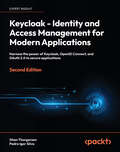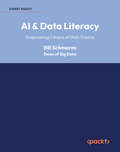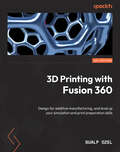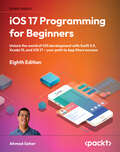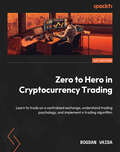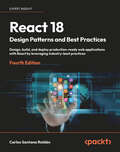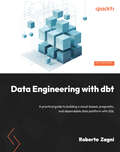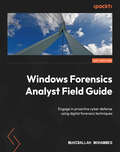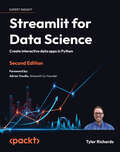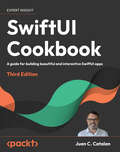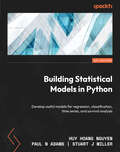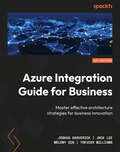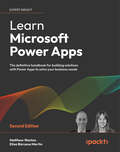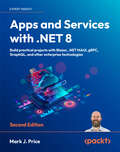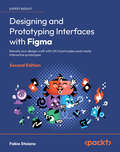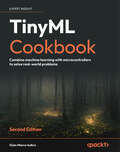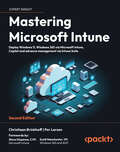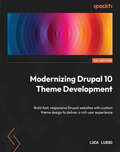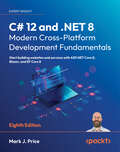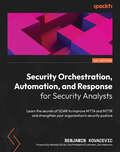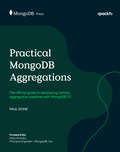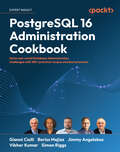- Table View
- List View
Keycloak - Identity and Access Management for Modern Applications: Harness the power of Keycloak, OpenID Connect, and OAuth 2.0 to secure applications
by Stian Thorgersen Pedro Igor SilvaGain a practical understanding of Keycloak to enable authentication and authorization in applications while leveraging the additional features provided by Keycloak. Purchase of the print or Kindle book includes a free PDF eBookKey FeaturesA beginners’ guide to Keycloak focussed on understanding Identity and Access ManagementImplement authentication and authorization in applications using Keycloak 22Utilize Keycloak in securing applications developed by you and the existing applications in your enterpriseBook DescriptionThe second edition of Keycloak - Identity and Access Management for Modern Applications is an updated, comprehensive introduction to Keycloak and its updates. In this new edition, you will learn how to use the latest distribution of Keycloak. The recent versions of Keycloak are now based on Quarkus, which brings a new and improved user experience and a new admin console with a higher focus on usability. You will see how to leverage Spring Security, instead of the Keycloak Spring adapter while using Keycloak 22. As you progress, you’ll understand the new Keycloak distribution and explore best practices in using OAuth. Finally, you'll cover general best practices and other information on how to protect your applications. By the end of this new edition, you’ll have learned how to install and manage the latest version of Keycloak to secure new and existing applications using the latest features.What you will learnUnderstand how to install, configure, and manage the latest version of KeycloakDiscover how to obtain access tokens through OAuth 2.0Utilize a reverse proxy to secure an application implemented in any programming language or frameworkSafely manage Keycloak in a production environmentSecure different types of applications, including web, mobile, and native applicationsDiscover the frameworks and third-party libraries that can expand KeycloakWho this book is forThis book is for developers, sysadmins, security engineers, or anyone who wants to leverage Keycloak and its capabilities for application security. Basic knowledge of app development, authentication, and authorization is expected.
AI & Data Literacy: Empowering Citizens of Data Science
by Bill SchmarzoLearn the key skills and capabilities that empower Citizens of Data Science to not only survive but thrive in an AI-dominated world. Purchase of the print or Kindle book includes a free PDF eBookKey FeaturesPrepare for a future dominated by AI and big dataEnhance your AI and data literacy with real-world examplesLearn how to leverage AI and data to address current and future challengesBook DescriptionAI is undoubtedly a game-changing tool with immense potential to improve human life. This book aims to empower you as a Citizen of Data Science, covering the privacy, ethics, and theoretical concepts you’ll need to exploit to thrive amid the current and future developments in the AI landscape. We'll explore AI's inner workings, user intent, and the critical role of the AI utility function while also briefly touching on statistics and prediction to build decision models that leverage AI and data for highly informed, more accurate, and less risky decisions. Additionally, we'll discuss how organizations of all sizes can leverage AI and data to engineer or create value. We'll establish why economies of learning are more powerful than the economies of scale in a digital-centric world. Ethics and personal/organizational empowerment in the context of AI will also be addressed. Lastly, we'll delve into ChatGPT and the role of Large Language Models (LLMs), preparing you for the growing importance of Generative AI. By the end of the book, you'll have a deeper understanding of AI and how best to leverage it and thrive alongside it.What you will learnGet to know the fundamentals of data literacy, privacy, and analyticsFind out what makes AI tick and the role of the AI utility functionMake informed decisions using prominent decision-making frameworksUnderstand relevant statistics and probability conceptsCreate new sources of value by leveraging and applying AI and dataApply ethical parameters to AI development with real-world examplesFind out how to get the most out of ChatGPT and its peersWho this book is forThis book is designed to benefit everyone from students to established business leaders and professionals who want to learn how to leverage data and analytics to accelerate their AI and Data literacy.
3D Printing with Fusion 360: Design for additive manufacturing, and level up your simulation and print preparation skills
by Sualp OzelElevate your Fusion 360 skills and streamline your 3D printing workflow by learning how to repair broken STLs, design for additive manufacturing, optimize part positioning, and slice your models in this user-friendly guide, complete with color imagesKey FeaturesCombine Fusion 360's powerful modeling capabilities with an intuitive interface to jump into 3D printing with confidenceLearn the entire workflow from design to 3D print using the software's powerful capabilitiesImport and repair external designs and create native lightweight designs for 3D printingPurchase of the print or Kindle book includes a free PDF eBookBook DescriptionAs 3D printing gains traction, the demand for CAD experts in manufacturing grows. If you're a fan of Autodesk Fusion and crave hands-on experience with automated modeling, generative design, and the full potential of additive manufacturing, this book is your guide to elevating your design and 3D printing skills. In this book, you’ll learn how to open CAD or Mesh files in Fusion and expertly repair, edit, and prepare them for 3D printing. You’ll unlock the secrets of effective print preparation, learning about print settings, support structures, and part orientation. This book also highlights Fusion’s diverse preferences designed specifically for additive manufacturing. Subsequent chapters will guide you in choosing the right part orientation and position, as well as creating suitable support structures based on your chosen printing technology. You’ll simulate the printing process to detect and remedy common print failures associated with the metal powder bed fusion process. Finally, you’ll leverage templates and scripts to automate routine tasks around print preparation. By the end of this 3D printing book, you'll be armed with the knowledge and skills necessary to harness the power of Fusion for additive manufacturing, meeting the growing demand with confidence.What you will learnUse Autodesk Fusion to open, inspect, repair, and edit externally created designs for 3D printingSet up your 3D prints for different printing technologies, such as FFF, SLA/DLP, SLS, and MPBFUse templates to automate your additive operations, including part orientation, arrangement, and supportRun process simulation for metal powder bed fusion and learn how to compensate for common print failure modesOptimize Fusion 360's preferences for 3D printingExport machine-specific file formats for 3D printing, such as G-Code, SLI, SLC, and CLIWho this book is forIf you're a designer using Autodesk Fusion on a daily basis and want to delve into 3D printing or craft functional, lightweight prints, this book is your go-to. It's also a valuable reference for intermediate-level Fusion users seeking insights into DFAM (design for additive manufacturing) and print preparation. To get the most out of this book, it's recommended that you have a good understanding of Fusion's design features, familiarity with opening CAD or MESH files, and prior experience creating components in Fusion.
iOS 17 Programming for Beginners: Unlock the world of iOS development with Swift 5.9, Xcode 15, and iOS 17 – your path to App Store success
by Ahmad Sahar Ian LockettEmbark on an exciting iOS app development journey with Swift 5.9, Xcode 15, and iOS 17. This hands-on guide equips you with the skills to create captivating apps and thrive in the competitive App Store landscape. Purchase of the print or Kindle book includes a free eBook in PDF format.Key FeaturesDive into the latest iOS 17 features and Swift 5.9 through hands-on projectsDevelop robust apps with top design patterns used by professionalsExpand your app's reach by effortlessly converting it for iPad, Mac, and visionOSBook DescriptionIn a world with nearly 2 million apps on the App Store, the demand for skilled iOS developers has never been higher. "iOS 17 Programming for Beginners, Eighth Edition" is your gateway to this lucrative and dynamic field. This hands-on guide is tailored for those who are new to iOS and takes you on a journey from learning the Swift language to crafting your own app and seeing it thrive on the App Store. Our approach is hands-on and practical. Each chapter is designed to be a stepping stone in your development journey, providing step-by-step tutorials, real-life examples, and clear explanations of complex concepts. As you progress, you'll not only be skilled in Swift but also incorporate cutting-edge technologies into your apps. You'll learn how to publish your creations and harness the power of iOS 17 through a straightforward and easy to program example app divided into manageable parts. By the time you've completed this book, you'll possess the skills and knowledge to not only develop and publish captivating apps but also leverage online resources to continually enhance your app development prowess.What you will learnDiscover the world of Xcode 15 and Swift 5.9, laying the foundation for your iOS development journeyImplement the latest iOS 17 features through a hands-on example app, ensuring your apps remain innovative and engagingBuild and deploy iOS apps using industry-standard design patterns and best practices.Implement the Model-View-Controller (MVC) design pattern to create robust and organized applicationsExpand your app's reach by effortlessly converting it for iPad, Mac, and visionOSDive into UIKit, the essential framework for large-scale iOS projectsWho this book is forThis book is tailored for individuals with minimal coding experience who are new to the world of Swift and iOS app development. A basic understanding of programming concepts is recommended.
Zero to Hero in Cryptocurrency Trading: Learn to trade on a centralized exchange, understand trading psychology, and implement a trading algorithm
by Bogdan VaidaGo from the bare basics to implementing your own automatic trading algorithm and become a cryptocurrency trading proKey FeaturesExcel at crypto trading with structured methodologies, practical examples, and real-time trading scenariosGo from the theoretical know-how to developing and testing your own strategyTransform manual trades into an automated algorithm for nonstop tradesPurchase of the print or Kindle book includes a free PDF eBookBook DescriptionIn today's fast-paced digital age, cryptocurrencies have emerged as a revolutionary financial asset class, capturing the attention of investors and traders worldwide. However, navigating the world of cryptocurrency trading can be overwhelming for beginners. Zero to Hero in Cryptocurrency Trading acts as a guiding light to navigate this complex realm. This comprehensive guide to cryptocurrency trading empowers you to go from a novice trader to a proficient investor by helping you implement your own trading strategy. As you progress, you’ll gain structured trading knowledge through hands-on examples and real-time scenarios, bolstered by trading psychology and money management techniques. You’ll be able to automate your manual trades with an algorithm that works even while you sleep. You’ll also benefit from interactive teaching methods, including screenshots, charts, and drawings to help decode market operations and craft your unique edge in the dynamic crypto world. As an added bonus, you’ll receive ready-to-use templates to identify useful indicators, test your strategy, and even maintain a trading journal. By the end of this book, you’ll be well-equipped to trade cryptocurrencies and automate manual trading to give you an edge in the markets.What you will learnMaster trading psychology and prevent emotions from sabotaging tradesManage risks by identifying and tailoring specific risk profilesInterpret, assess, and integrate technical indicators in your tradingGet to grips with trading on a centralized exchangeGet a deeper understanding of risk and money managementGain an edge by identifying trading patternsAutomate the patterns into a strategy for a bot that operates 24/7Who this book is forThis book is for finance and investment professionals, crypto market enthusiasts, and anyone new to trading who wants to kickstart their cryptocurrency trading journey. A basic understanding of cryptocurrencies is a must, but prior trading experience is not necessary.
React 18 Design Patterns and Best Practices, 4e: Design, build, and deploy production-ready web applications with React by leveraging industry-best practices
by Carlos Santana RoldánDive in and discover how to build awesome React web apps that you can scale and maintain using design patterns and the latest industry insights Purchase of the print or Kindle book includes a free PDF eBookKey FeaturesDiscover and unpack the latest React 18 and Node 19 features in this updated fourth editionGet up to speed with TypeScript, MonoRepo architecture, and several cutting-edge React toolsLearn from plenty of real-world examples and an improved chapter flowBook DescriptionReact helps you work smarter, not harder — but to reap the benefits of this popular JavaScript library and its components, you need a straightforward guide that will teach you how to make the most of it. React 18 Design Patterns and Best Practices will help you use React effectively to make your applications more flexible, easier to maintain, and improve their performance, while giving your workflow a huge boost. With a better organization of topics and knowledge about best practices added to your developer toolbox, the updated fourth edition ensures an enhanced learning experience. The book is split into three parts; the first will teach you the fundamentals of React patterns, the second will dive into how React works, and the third will focus on real-world applications. All the code samples are updated to the latest version of React and you’ll also find plenty of new additions that explore React 18 and Node 19’s newest features, alongside MonoRepo Architecture and a dedicated chapter on TypeScript. By the end of this book, you'll be able to efficiently build and deploy real-world React web applications.What you will learnGet familiar with the new React 18 and Node 19 featuresExplore TypeScript's basic and advanced capabilitiesMake components communicate with each other by applying various patterns and techniquesDive into MonoRepo architectureUse server-side rendering to make applications load fasterWrite a comprehensive set of tests to create robust and maintainable codeBuild high-performing applications by styling and optimizing React componentsWho this book is forThis book is for web developers who want to master React by learning key design patterns and best practices in real-world application development. You’ll need an intermediate-level experience with React and JavaScript before you get started.
Data Engineering with dbt: A practical guide to building a cloud-based, pragmatic, and dependable data platform with SQL
by Roberto ZagniUse easy-to-apply patterns in SQL and Python to adopt modern analytics engineering to build agile platforms with dbt that are well-tested and simple to extend and run Purchase of the print or Kindle book includes a free PDF eBookKey FeaturesBuild a solid dbt base and learn data modeling and the modern data stack to become an analytics engineerBuild automated and reliable pipelines to deploy, test, run, and monitor ELTs with dbt CloudGuided dbt + Snowflake project to build a pattern-based architecture that delivers reliable datasetsBook Descriptiondbt Cloud helps professional analytics engineers automate the application of powerful and proven patterns to transform data from ingestion to delivery, enabling real DataOps. This book begins by introducing you to dbt and its role in the data stack, along with how it uses simple SQL to build your data platform, helping you and your team work better together. You’ll find out how to leverage data modeling, data quality, master data management, and more to build a simple-to-understand and future-proof solution. As you advance, you’ll explore the modern data stack, understand how data-related careers are changing, and see how dbt enables this transition into the emerging role of an analytics engineer. The chapters help you build a sample project using the free version of dbt Cloud, Snowflake, and GitHub to create a professional DevOps setup with continuous integration, automated deployment, ELT run, scheduling, and monitoring, solving practical cases you encounter in your daily work. By the end of this dbt book, you’ll be able to build an end-to-end pragmatic data platform by ingesting data exported from your source systems, coding the needed transformations, including master data and the desired business rules, and building well-formed dimensional models or wide tables that’ll enable you to build reports with the BI tool of your choice.What you will learnCreate a dbt Cloud account and understand the ELT workflowCombine Snowflake and dbt for building modern data engineering pipelinesUse SQL to transform raw data into usable data, and test its accuracyWrite dbt macros and use Jinja to apply software engineering principlesTest data and transformations to ensure reliability and data qualityBuild a lightweight pragmatic data platform using proven patternsWrite easy-to-maintain idempotent code using dbt materializationWho this book is forThis book is for data engineers, analytics engineers, BI professionals, and data analysts who want to learn how to build simple, futureproof, and maintainable data platforms in an agile way. Project managers, data team managers, and decision makers looking to understand the importance of building a data platform and foster a culture of high-performing data teams will also find this book useful. Basic knowledge of SQL and data modeling will help you get the most out of the many layers of this book. The book also includes primers on many data-related subjects to help juniors get started.
Windows Forensics Analyst Field Guide: Engage in proactive cyber defense using digital forensics techniques
by Muhiballah MohammedBuild your expertise in Windows incident analysis by mastering artifacts and techniques for efficient cybercrime investigation with this comprehensive guideKey FeaturesGain hands-on experience with reputable and reliable tools such as KAPE and FTK ImagerExplore artifacts and techniques for successful cybercrime investigation in Microsoft Teams, email, and memory forensicsUnderstand advanced browser forensics by investigating Chrome, Edge, Firefox, and IE intricaciesPurchase of the print or Kindle book includes a free PDF eBookBook DescriptionIn this digitally driven era, safeguarding against relentless cyber threats is non-negotiable. This guide will enable you to enhance your skills as a digital forensic examiner by introducing you to cyber challenges that besiege modern entities. It will help you to understand the indispensable role adept digital forensic experts play in preventing these threats and equip you with proactive tools to defend against ever-evolving cyber onslaughts. The book begins by unveiling the intricacies of Windows operating systems and their foundational forensic artifacts, helping you master the art of streamlined investigative processes. From harnessing opensource tools for artifact collection to delving into advanced analysis, you’ll develop the skills needed to excel as a seasoned forensic examiner. As you advance, you’ll be able to effortlessly amass and dissect evidence to pinpoint the crux of issues. You’ll also delve into memory forensics tailored for Windows OS, decipher patterns within user data, and log and untangle intricate artifacts such as emails and browser data. By the end of this book, you’ll be able to robustly counter computer intrusions and breaches, untangle digital complexities with unwavering assurance, and stride confidently in the realm of digital forensics.What you will learnMaster the step-by-step investigation of efficient evidence analysisExplore Windows artifacts and leverage them to gain crucial insightsAcquire evidence using specialized tools such as FTK Imager to maximize retrievalGain a clear understanding of Windows memory forensics to extract key insightsExperience the benefits of registry keys and registry tools in user profiling by analyzing Windows registry hivesDecode artifacts such as emails, applications execution, and Windows browsers for pivotal insightsWho this book is forThis book is for forensic investigators with basic experience in the field, cybersecurity professionals, SOC analysts, DFIR analysts, and anyone interested in gaining deeper knowledge of Windows forensics. It's also a valuable resource for students and beginners in the field of IT who’re thinking of pursuing a career in digital forensics and incident response.
Zero Trust Overview and Playbook Introduction: Guidance for business, security, and technology leaders and practitioners
by Mark Simos Nikhil KumarEnhance your cybersecurity and agility with this thorough playbook, featuring actionable guidance, insights, and success criteria from industry expertsKey FeaturesGet simple, clear, and practical advice for everyone from CEOs to security operationsOrganize your Zero Trust journey into role-by-role execution stagesIntegrate real-world implementation experience with global Zero Trust standardsPurchase of the print or Kindle book includes a free eBook in the PDF formatBook DescriptionZero Trust is cybersecurity for the digital era and cloud computing, protecting business assets anywhere on any network. By going beyond traditional network perimeter approaches to security, Zero Trust helps you keep up with ever-evolving threats. The playbook series provides simple, clear, and actionable guidance that fully answers your questions on Zero Trust using current threats, real-world implementation experiences, and open global standards. The Zero Trust playbook series guides you with specific role-by-role actionable information for planning, executing, and operating Zero Trust from the boardroom to technical reality. This first book in the series helps you understand what Zero Trust is, why it’s important for you, and what success looks like. You’ll learn about the driving forces behind Zero Trust – security threats, digital and cloud transformations, business disruptions, business resilience, agility, and adaptability. The six-stage playbook process and real-world examples will guide you through cultural, technical, and other critical elements for success. By the end of this book, you’ll have understood how to start and run your Zero Trust journey with clarity and confidence using this one-of-a-kind series that answers the why, what, and how of Zero Trust!What you will learnFind out what Zero Trust is and what it means to youUncover how Zero Trust helps with ransomware, breaches, and other attacksUnderstand which business assets to secure firstUse a standards-based approach for Zero TrustSee how Zero Trust links business, security, risk, and technologyUse the six-stage process to guide your Zero Trust journeyTransform roles and secure operations with Zero TrustDiscover how the playbook guides each role to successWho this book is forWhether you’re a business leader, security practitioner, or technology executive, this comprehensive guide to Zero Trust has something for you. This book provides practical guidance for implementing and managing a Zero Trust strategy and its impact on every role (including yours!). This is the go-to guide for everyone including board members, CEOs, CIOs, CISOs, architects, engineers, IT admins, security analysts, program managers, product owners, developers, and managers. Don't miss out on this essential resource for securing your organization against cyber threats.
Streamlit for Data Science: Create interactive data apps in Python
by Tyler RichardsAn easy-to-follow and comprehensive guide to creating data apps with Streamlit, including how-to guides for working with cloud data warehouses like Snowflake, using pretrained Hugging Face and OpenAI models, and creating apps for job interviews.Key FeaturesCreate machine learning apps with random forest, Hugging Face, and GPT-3.5 turbo modelsGain an insight into how experts harness Streamlit with in-depth interviews with Streamlit power usersDiscover the full range of Streamlit’s capabilities via hands-on exercises to effortlessly create and deploy well-designed appsBook DescriptionIf you work with data in Python and are looking to create data apps that showcase ML models and make beautiful interactive visualizations, then this is the ideal book for you. Streamlit for Data Science, Second Edition, shows you how to create and deploy data apps quickly, all within Python. This helps you create prototypes in hours instead of days! Written by a prolific Streamlit user and senior data scientist at Snowflake, this fully updated second edition builds on the practical nature of the previous edition with exciting updates, including connecting Streamlit to data warehouses like Snowflake, integrating Hugging Face and OpenAI models into your apps, and connecting and building apps on top of Streamlit databases. Plus, there is a totally updated code repository on GitHub to help you practice your newfound skills. You'll start your journey with the fundamentals of Streamlit and gradually build on this foundation by working with machine learning models and producing high-quality interactive apps. The practical examples of both personal data projects and work-related data-focused web applications will help you get to grips with more challenging topics such as Streamlit Components, beautifying your apps, and quick deployment. By the end of this book, you'll be able to create dynamic web apps in Streamlit quickly and effortlessly.What you will learnSet up your first development environment and create a basic Streamlit app from scratchCreate dynamic visualizations using built-in and imported Python librariesDiscover strategies for creating and deploying machine learning models in StreamlitDeploy Streamlit apps with Streamlit Community Cloud, Hugging Face Spaces, and HerokuIntegrate Streamlit with Hugging Face, OpenAI, and SnowflakeBeautify Streamlit apps using themes and componentsImplement best practices for prototyping your data science work with StreamlitWho this book is forThis book is for data scientists and machine learning enthusiasts who want to get started with creating data apps in Streamlit. It is terrific for junior data scientists looking to gain some valuable new skills in a specific and actionable fashion and is also a great resource for senior data scientists looking for a comprehensive overview of the library and how people use it. Prior knowledge of Python programming is a must, and you’ll get the most out of this book if you’ve used Python libraries like Pandas and NumPy in the past.
SwiftUI Cookbook: A guide for building beautiful and interactive SwiftUI apps
by Juan C. CatalanExperience the potential of SwiftUI, Swift 5.9, and Xcode 15 for crafting cutting-edge apps on iOS 17, macOS 14.0 Sonoma, and watchOS 10Key FeaturesUnlock advanced controls and animations with SwiftUI 5, taking your app development skills to the next levelVisualize data effortlessly using Swift Charts enhancing your app's data-driven capabilitiesDevelop for multiple platforms, including iOS, macOS, and watchOS, and become a versatile app developerPurchase of the print or Kindle book includes a free PDF eBookBook DescriptionSwiftUI is the modern way to build user interfaces for iOS, macOS, and watchOS. It provides a declarative and intuitive way to create beautiful and interactive user interfaces. The new edition of this comprehensive cookbook includes a fully updated repository for SwiftUI 5, iOS 17, Xcode 15, and Swift 5.9. With this arsenal, it teaches you everything you need to know to build beautiful and interactive user interfaces with SwiftUI 5, from the basics to advanced topics like custom modifiers, animations, and state management. In this new edition, you will dive into the world of creating powerful data visualizations with a new chapter on Swift Charts and how to seamlessly integrate charts into your SwiftUI apps. Further, you will be able to unleash your creativity with advanced controls, including multi-column tables and two-dimensional layouts. You can explore new modifiers for text, images, and shapes that give you more control over the appearance of your views. You will learn how to develop apps for multiple platforms, including iOS, macOS, watchOS, and more. With expert insights, real-world examples, and a recipe-based approach, you’ll be equipped to build remarkable SwiftUI apps that stand out in today’s competitive market.What you will learnCreate stunning, user-friendly apps for iOS 17, macOS 14, and watchOS 10 with SwiftUI 5Use the advanced preview capabilities of Xcode 15Use async/await to write concurrent and responsive codeCreate powerful data visualizations with Swift ChartsEnhance user engagement with modern animations and transitionsImplement user authentication using Firebase and Sign in with AppleLearn about advanced topics like custom modifiers, animations, and state managementBuild multi-platform apps with SwiftUIWho this book is forThis book is for mobile developers who want to learn SwiftUI as well as experienced iOS developers transitioning from UIKit to SwiftUI. The book assumes knowledge of the Swift programming language. Knowledge of object-oriented design and data structures will be useful but not necessary. You'll also find this book to be a helpful resource if you're looking for reference material regarding the implementation of various features in SwiftUI.
Building Statistical Models in Python: Develop useful models for regression, classification, time series, and survival analysis
by Huy Hoang Nguyen Paul N Adams Stuart J MillerMake data-driven, informed decisions and enhance your statistical expertise in Python by turning raw data into meaningful insights Purchase of the print or Kindle book includes a free PDF eBookKey FeaturesGain expertise in identifying and modeling patterns that generate successExplore the concepts with Python using important libraries such as stats modelsLearn how to build models on real-world data sets and find solutions to practical challengesBook DescriptionThe ability to proficiently perform statistical modeling is a fundamental skill for data scientists and essential for businesses reliant on data insights. Building Statistical Models with Python is a comprehensive guide that will empower you to leverage mathematical and statistical principles in data assessment, understanding, and inference generation. This book not only equips you with skills to navigate the complexities of statistical modeling, but also provides practical guidance for immediate implementation through illustrative examples. Through emphasis on application and code examples, you’ll understand the concepts while gaining hands-on experience. With the help of Python and its essential libraries, you’ll explore key statistical models, including hypothesis testing, regression, time series analysis, classification, and more. By the end of this book, you’ll gain fluency in statistical modeling while harnessing the full potential of Python's rich ecosystem for data analysis.What you will learnExplore the use of statistics to make decisions under uncertaintyAnswer questions about data using hypothesis testsUnderstand the difference between regression and classification modelsBuild models with stats models in PythonAnalyze time series data and provide forecastsDiscover Survival Analysis and the problems it can solveWho this book is forIf you are looking to get started with building statistical models for your data sets, this book is for you! Building Statistical Models in Python bridges the gap between statistical theory and practical application of Python. Since you’ll take a comprehensive journey through theory and application, no previous knowledge of statistics is required, but some experience with Python will be useful.
Azure Integration Guide for Business: Master effective architecture strategies for business innovation
by Joshua Garverick Jack Lee Mélony Qin Trevoir WilliamsLeverage the cloud to optimize costs, improve security, and seamlessly scale your business operationsKey FeaturesAchieve your operational goals with Azure infrastructureOptimize costs with serverless event-driven solutions through Azure cloud patternsBoost productivity with Azure architecture’s flexibility and scalabilityPurchase of the print or Kindle book includes a free PDF eBookBook DescriptionAzure Integration Guide for Business is essential for decision makers planning to transform their business with Microsoft Azure. The Microsoft Azure cloud platform can improve the availability, scalability, and cost-efficiency of any business. The guidance in this book will help decision makers gain valuable insights into proactively managing their applications and infrastructure. You'll learn to apply best practices in Azure Virtual Network and Azure Storage design, ensuring an efficient and secure cloud infrastructure. You'll also discover how to automate Azure through Infrastructure as Code (IaC) and leverage various Azure services to support OLTP applications. Next, you’ll explore how to implement Azure offerings for event-driven architectural solutions and serverless applications. Additionally, you’ll gain in-depth knowledge on how to develop an automated, secure, and scalable solutions. Core elements of the Azure ecosystem will be discussed in the final chapters of the book, such as big data solutions, cost governance, and best practices to help you optimize your business. By the end of this book, you’ll understand what a well-architected Azure solution looks like and how to lead your organization toward a tailored Azure solution that meets your business needs.What you will learnOptimize the performance and costs with AzureSelect an effective, scalable, and flexible solution that aligns with your needsHarness the power of containers to drive your application development and deploymentCreate big data solutions with the best Azure tools, platforms, and resourcesExplore the benefits of automation for enhanced productivityImprove the availability and effectiveness of monitoring with AzureWho this book is forThis book is for business decision makers looking to benefit from the flexibility, scalability, and optimized costs offered by Microsoft Azure to scale their businesses. Basic knowledge of Azure is recommended to get the most out of this book.
Learn Microsoft Power Apps: The definitive handbook for building solutions with Power Apps to solve your business needs
by Matthew Weston Elisa Bárcena MartínA step-by-step guide that will help you create, share, and deploy applications across your organization using Microsoft Power Apps Purchase of the print or Kindle book includes a free PDF eBookKey FeaturesBuild apps from scratch to solve real-world business scenarios Learn how to keep app data secure with expanded coverage on DataverseIncorporate AI into your app building process using AI Builder and CopilotBook DescriptionMicrosoft Power Apps provides a modern approach to building low-code business applications for mobiles, tablets, browsers, and Microsoft Teams. The second edition of Learn Microsoft Power Apps will guide you in creating well designed and secure apps that transform old processes and workflows. Learn Microsoft Power Apps starts with an introduction to Power Apps to help you feel comfortable with the creation experience. Using screenshots from the latest UI, you will be guided through how to create an app, building your confidence to start developing further. This book will help you design, set up, and configure your first application by writing simple formulas. You'll learn about the different types of apps you can build in Power Apps and which one applies best to your requirements. In addition to this, you’ll learn how to identify the right data storage system for you, with new chapters covering how to integrate apps with SharePoint or Dataverse. As you advance, you’ll be able to use various controls, connectors, and data sources to create a powerful, interactive app. For example, this book will help you understand how Power Apps can use Microsoft Power Automate, Power BI, and Azure functionalities to improve your applications. Finally, you will be introduced to the emerging Power Apps Copilot tool, which uses artificial intelligence to accelerate the app building process. By the end of this Power Apps book, you’ll be ready to confidently develop lightweight business applications with minimal code.What you will learnUnderstand the Power Apps ecosystem and licensingTake your first steps building canvas appsDevelop apps using intermediate techniques such as the barcode scanner and GPS controlsExplore new connectors to integrate tools across the Power PlatformStore data in Dataverse using model-driven appsDiscover the best practices for building apps cleanly and effectivelyUse AI for app development with AI Builder and CopilotWho this book is forThis book is intended for business analysts, IT professionals, and both developers and non-developers alike. If you want to meet business needs by creating purpose-built apps, this book is for you. To get the most out of this book, it is recommended that you have a basic understanding of Microsoft 365 as you will interact with various elements of it while developing apps.
Apps and Services with .NET 8: Build practical projects with Blazor, .NET MAUI, gRPC, GraphQL, and other enterprise technologies
by Mark J. PriceBestselling author Mark Price is back to guide you through the latest and most common technologies a .NET developer should know: Blazor Full Stack, ASP.NET Core MVC, ASP.NET Core Minimal APIs, .NET MAUI, gRPC, GraphQL, SQL Server, Cosmos DB, SignalR, Azure Functions, and more! Purchase of the print or Kindle book includes a free eBook in PDF format.Key FeaturesUse specialized libraries to improve all aspects of your apps, including performance, security, and localizationHarness the full potential of .NET using cloud-native data stores like Cosmos DB, and unlock scalability, performance, and resilience in your service implementationsUnleash the capabilities of Blazor Full Stack and.NET MAUI to develop stunning, truly cross-platform apps for web and mobileBook DescriptionElevate your practical C# and .NET skills to the next level with this new edition of Apps and Services with .NET 8. With chapters that put a variety of technologies into practice, including Web API, gRPC, GraphQL, and SignalR, this book will give you a broader scope of knowledge than other books that often focus on only a handful of .NET technologies. You’ll dive into the new unified model for Blazor Full Stack and leverage .NET MAUI to develop mobile and desktop apps. This new edition introduces the latest enhancements, including the seamless implementation of web services with ADO.NET SqlClient's native Ahead-of-Time (AOT) support. Popular library coverage now includes Humanizer and Noda Time. There’s also a brand-new chapter that delves into service architecture, caching, queuing, and robust background services. By the end of this book, you’ll have a wide range of best practices and deep insights under your belt to help you build rich apps and efficient services.What you will learnFamiliarize yourself with a variety of technologies to implement services, such as gRPC and GraphQLStore and manage data locally and cloud-natively with SQL Server and Cosmos DBUse ADO.NET SqlClient to implement web services with native AOT publish supportLeverage Dapper for improved performance over EF CoreImplement popular third-party libraries such as Serilog, FluentValidation, Humanizer, and Noda TimeExplore the new unified hosting model of Blazor Full StackWho this book is forThis book is for .NET developers interested in exploring more specialized libraries and implementation fundamentals behind building services and apps. You’ll need to know your way around .NET and C# quite well before you can dive in, so if you want to work your way up to this book, you can pick up Mark’s other .NET book, C# 12 and .NET 8 – Modern Cross-Platform Development Fundamentals, first.
Designing and Prototyping Interfaces with Figma: Elevate your design craft with UX/UI principles and create interactive prototypes
by Fabio StaianoExplore the latest Figma features with this newly updated 2nd edition, including Variables and Conditional Prototyping. Learn cutting-edge design principles and create captivating interfaces with this full-color guide.Key FeaturesExplore Figma's latest features, including Variables and Conditional Prototyping, to create dynamic and responsive interfacesIntegrate AI capabilities and optimize your workflow with the latest Figma pluginsCreate engaging, interactive prototypes that captivate your users and stakeholdersPurchase of the print or Kindle book includes a free PDF eBookBook DescriptionAre you a UI/UX designer eager to learn the art of creating compelling interfaces using Figma? Look no further! The highly anticipated new edition is here to transform your creative journey. Explore Figma's latest features and delve into the power of variables and conditional Prototyping. Get ready to transform your static designs into dynamic, interactive prototypes, offering users and stakeholders an immersive experience. Stay at the forefront of design innovation with insights into integrating AI capabilities and optimizing your workflow with the latest Figma plugins. With user-centric design at its core, this book guides you through mastering design thinking, enabling you to tackle complex design challenges with ease. One unique aspect of this edition is its focus on effective communication. Learn how to convey your design vision clearly to both technical and non-technical audiences. In the rapidly changing world of UI/UX design, iteration is key. This book will teach you how to gather user feedback and iterate on your designs by creating interactive prototypes. Whether you're new to Figma or a seasoned pro, this comprehensive guide equips you with the skills to create captivating interfaces, fosters creativity and problem-solving, and makes you an indispensable, forward-thinking designer.What you will learnCreate high-quality designs that cater to your users' needs, providing an outstanding experienceMastering mobile-first design and responsive design conceptsIntegrate AI capabilities into your design workflow to boost productivity and explore design innovationCraft immersive prototypes with conditional prototyping and variablesCommunicate effectively to technical and non-technical audiencesDevelop creative solutions for complex design challengesGather and apply user feedback through interactive prototypesWho this book is forThis book is for aspiring UX/UI designers who want to get started with Figma as well as established designers who want to migrate to Figma from other design tools. This guide will provide you a walkthrough of the entire process of creating a full-fledged prototype for a responsive interface using all the tools and features that Figma has to offer. As a result, this book is suitable for both UX and UI designers, product and graphic designers, as well as anyone who wants to explore the complete design process from scratch.
TinyML Cookbook: Combine machine learning with microcontrollers to solve real-world problems
by Gian Marco IodiceOver 70 recipes to help you develop smart applications on Arduino Nano 33 BLE Sense, Raspberry Pi Pico, and SparkFun RedBoard Artemis Nano using the power of machine learning Purchase of the print or Kindle book includes a free eBook in PDF format.Key FeaturesOver 20+ new recipes, including recognizing music genres and detecting objects in a sceneCreate practical examples using TensorFlow Lite for Microcontrollers, Edge Impulse, and moreExplore cutting-edge technologies, such as on-device training for updating models without data leaving the deviceBook DescriptionDiscover the incredible world of tiny Machine Learning (tinyML) and create smart projects using real-world data sensors with the Arduino Nano 33 BLE Sense, Raspberry Pi Pico, and SparkFun RedBoard Artemis Nano. TinyML Cookbook, Second Edition, will show you how to build unique end-to-end ML applications using temperature, humidity, vision, audio, and accelerometer sensors in different scenarios. These projects will equip you with the knowledge and skills to bring intelligence to microcontrollers. You'll train custom models from weather prediction to real-time speech recognition using TensorFlow and Edge Impulse.Expert tips will help you squeeze ML models into tight memory budgets and accelerate performance using CMSIS-DSP. This improved edition includes new recipes featuring an LSTM neural network to recognize music genres and the Faster-Objects-More-Objects (FOMO) algorithm for detecting objects in a scene. Furthermore, you’ll work on scikit-learn model deployment on microcontrollers, implement on-device training, and deploy a model using microTVM, including on a microNPU. This beginner-friendly and comprehensive book will help you stay up to date with the latest developments in the tinyML community and give you the knowledge to build unique projects with microcontrollers!What you will learnUnderstand the microcontroller programming fundamentalsWork with real-world sensors, such as the microphone, camera, and accelerometerImplement an app that responds to human voice or recognizes music genresLeverage transfer learning with FOMO and KerasLearn best practices on how to use the CMSIS-DSP libraryCreate a gesture-recognition app to build a remote controlDesign a CIFAR-10 model for memory-constrained microcontrollersTrain a neural network on microcontrollersWho this book is forThis book is ideal for machine learning engineers or data scientists looking to build embedded/edge ML applications and IoT developers who want to add machine learning capabilities to their devices. If you’re an engineer, student, or hobbyist interested in exploring tinyML, then this book is your perfect companion. Basic familiarity with C/C++ and Python programming is a prerequisite; however, no prior knowledge of microcontrollers is necessary to get started with this book.
Mastering Microsoft Intune: Deploy Windows 11, Windows 365 via Microsoft Intune, Copilot and advance management via Intune Suite
by Christiaan Brinkhoff Per LarsenGet ready to master Microsoft Intune and revolutionize your endpoint management strategy with this comprehensive guide and provide next-level security with the Intune Suite. Includes forewords from Scott Manchester, Vice President, Windows 365 + AVD and Steve Dispensa Corporate Vice President, Microsoft Intune.Key FeaturesThis new edition covers the latest updates of Microsoft Intune, Windows 365, Intune Suite, Windows Autopatch, Microsoft Defender and Universal PrintGet detailed guidance on device enrolment, app deployment, management, data security, and policy configurationSecure data on personal devices with app policies, encryption, and moreBook DescriptionThe slow adoption of modern Work solutions, which are designed to streamline the management of your environment, can often be attributed to a lack of understanding and familiarity with those solutions. This book will provide you with all the information you need to successfully transition to Microsoft Intune. Mastering Microsoft Intune, Second Edition, explains various concepts in detail to give you the clarity on how to use Microsoft Intune and eliminate any migration challenges. You'll master Cloud Computing services such as Windows 365 Cloud PCs, Intune Suite, Windows Autopatch, Windows Autopilot, profile management, monitoring and analytics, Universal Print, and much more. The book will take you through the latest features and new Microsoft Cloud services to help you to get grips with the fundamentals of Intune and understand which services you can manage. Whether you're interested in physical or cloud endpoints it's all covered. By the end of the book, you'll be able to set up Intune and use it to run Windows and Windows 365 efficiently, using all the latest features of Intune.What you will learnSimplify the deployment of Windows in the cloud with Windows 365 Cloud PCsDeliver next-generation security features with Intune SuiteSimplify Windows Updates with Windows AutopatchConfigure advanced policy management within IntuneDiscover modern profile management and migration options for physical and Cloud PCsHarden security with baseline settings and other security best practicesFind troubleshooting tips and tricks for Intune, Windows 365 Cloud PCs, and moreDiscover deployment best practices for physical and cloud-managed endpointsWho this book is forIf you're an IT professional, enterprise mobility administrator, architect, or consultant looking to learn about managing Windows on both physical and cloud endpoints using Microsoft Intune, then this book is for you.
Modernizing Drupal 10 Theme Development: Build fast, responsive Drupal websites with custom theme design to deliver a rich user experience
by Luca LussoA comprehensive guide to creating Drupal themes from scratch, from design to fully styled websites with custom Twig templates and headless architectureKey FeaturesExplore real-world examples with proven methodologies to gain a deeper insight into the Drupal theme layerLearn how to translate a graphic design into a maintainable and robust Drupal themeImprove performance and accessibility with a decoupled frontend to consume data exposed by Drupal’s APIsPurchase of the print or Kindle book includes a free PDF eBookBook DescriptionWorking with themes in Drupal can be challenging, given the number of layers and APIs involved. Modernizing Drupal 10 Theme Development helps you explore the new Drupal 10’s theme layer in depth. With a fully implemented Drupal website on the one hand and a set of Storybook components on the other, you’ll begin by learning to create a theme from scratch to match the desired final layout. Once you’ve set up a local environment, you’ll get familiarized with design systems and learn how to map them to the structures of a Drupal website. Next, you’ll bootstrap your new theme and optimize Drupal’s productivity using tools such as webpack, Tailwind CSS, and Browsersync. As you advance, you’ll delve into all the theme layers in a step-by-step way, starting from how Drupal builds an HTML page to where the template files are and how to add custom CSS and JavaScript. You’ll also discover how to leverage all the Drupal APIs to implement robust and maintainable themes without reinventing the wheel, but by following best practices and methodologies. Toward the end, you’ll find out how to build a fully decoupled website using json:api and Next.js. By the end of this book, you’ll be able to confidently build custom Drupal themes to deliver state-of-the-art websites and keep ahead of the competition in the modern frontend world.What you will learnMap design systems made by Storybook components to Drupal structuresUnderstand and use render arrays and Twig templatesGet familiarized with the new Single Directory Component feature introduced in Drupal 10.1Define, import, and use CSS and JavaScript librariesDiscover how to style content created with fields and paragraphsDefine, place, customize, and style blocksExplore advanced topics like extending Twig, making a theme configurable, and boosting performance and accessibilityFind out how to build a decoupled website using json:api and Next.jsWho this book is forIf you are a Drupal backend developer or frontend developer who wants to create Drupal themes that follow industry best practices and are fast and maintainable, this book is for you. Basic knowledge of HTML, CSS, and JavaScript and working knowledge of a CMS are needed to grasp the concepts present in this book.
C# 12 and .NET 8 – Modern Cross-Platform Development Fundamentals: Start building websites and services with ASP.NET Core 8, Blazor, and EF Core 8
by Mark J. PriceAn accessible guide for beginner-to-intermediate programmers to the concepts, real-world applications, and latest features of C# 12 and .NET 8, with hands-on exercises using Visual Studio 2022 and Visual Studio Code. Purchase of the print or Kindle book includes a free PDF eBookKey FeaturesExplore the latest additions to C# 12, the .NET 8 class libraries, and Entity Framework Core 8Create professional websites and services with ASP.NET Core 8 and BlazorBuild your confidence with step-by-step code examples and tips for best practicesBook DescriptionThis latest edition of the bestselling Packt series will give you a solid foundation to start building projects using modern C# and .NET with confidence. You'll learn about object-oriented programming; writing, testing, and debugging functions; and implementing interfaces. You'll take on .NET APIs for managing and querying data, working with the fi lesystem, and serialization. As you progress, you'll explore examples of cross-platform projects you can build and deploy, such as websites and services using ASP.NET Core. This latest edition integrates .NET 8 enhancements into its examples: type aliasing and primary constructors for concise and expressive code. You'll handle errors robustly through the new built-in guard clauses and explore a simplified implementation of caching in ASP.NET Core 8. If that's not enough, you'll also see how native ahead-of-time (AOT) compiler publish lets web services reduce memory use and run faster. You'll work with the seamless new HTTP editor in Visual Studio 2022 to enhance the testing and debugging process. You'll even get introduced to Blazor Full Stack with its new unified hosting model for unparalleled web development flexibility.What you will learnDiscover C# 12's new features, including aliasing any type and primary constructorsTry out the native AOT publish capability for ASP.NET Core 8 Minimal APIs web servicesBuild rich web experiences using Blazor Full Stack, Razor Pages, and other ASP.NET Core featuresIntegrate and update databases in your apps using Entity Framework Core modelsQuery and manipulate data using LINQBuild and consume powerful services using Web API and Minimal APIWho this book is forThis book is for beginners as well as intermediate-level C# and .NET programmers who have worked with C# in the past and want to catch up with the changes made in the last few years. Prior exposure to C# or .NET is not a prerequisite. A general understanding of programming will help you to work through the book more comfortably, though the content is suitable for those completely new to programming. If you already have some C# and .NET skills and want to focus on developing practical apps, you can pick up Mark’s other .NET book, Apps and Services with .NET 8, instead.
Angular Cookbook: Over 80 actionable recipes every Angular developer should know
by Muhammad Ahsan AyazDiscover core concepts, advanced techniques, and end-to-end solutions for building production-ready applications Purchase of the print or Kindle book includes a free PDF eBook.Key FeaturesExplore updated and new recipes to fill gaps in your knowledge while using Angular in productionDiscover industry best practices and tooling to enhance your development experience with Angular’s renaissanceGain an understanding of advanced Angular topics to become a proficient enterprise web developerBook DescriptionAngular has long been the framework of choice for web development projects of various scales, offering much-needed stability and a rich tooling ecosystem for building production-ready web and mobile apps. This recipe-based guide ensures high performance apps with the latest version of Angular, helping you to build up your Angular expertise with a wide range of recipes across key tasks in web development. In this second edition, the recipes have been updated, added, and improved based on developer feedback, new challenges, and Angular 17. The first few chapters will show you how to utilize core Angular concepts such as components, directives, and services to get you ready for building frontend web apps. You’ll then develop web components with Angular and go on to learn about advanced concepts such as dynamic components loading and state management with NgRx for achieving real-time performance. Later chapters will focus on recipes for effectively testing your Angular apps to make them fail-safe, before progressing to techniques for optimizing your app’s performance. Finally, you’ll create Progressive Web Apps (PWA) with Angular to provide an intuitive experience for users. By the end of this book, you’ll be able to create full-fledged, professional-looking Angular apps and have the skills you need for frontend development. What you will learnGain a better understanding of how components, services, and directives work in AngularGet to grips with creating Progressive Web Apps using Angular from scratchBuild rich animations and add them to your Angular appsManage your app's data reactivity using RxJSImplement state management for your Angular apps with NgRxOptimize the performance of your new and existing web appsWrite fail-safe unit tests and end-to-end tests for your web apps using Jest and CypressGet familiar with Angular CDK components for designing effective Angular componentsWho this book is forThis book is for intermediate-level Angular developers looking for actionable solutions to common problems in Angular enterprise development. Mobile developers using Angular will also find the recipes in this book useful. Working experience with JavaScript and TypeScript is necessary to understand the topics covered in this book more effectively.
Security Orchestration, Automation, and Response for Security Analysts: Learn the secrets of SOAR to improve MTTA and MTTR and strengthen your organization's security posture
by Benjamin KovacevicBecome a security automation expert and build solutions that save time while making your organization more secureKey FeaturesWhat’s insideAn exploration of the SOAR platform’s full features to streamline your security operationsLots of automation techniques to improve your investigative abilityActionable advice on how to leverage the capabilities of SOAR technologies such as incident management and automation to improve security postureBook DescriptionWhat your journey will look like With the help of this expert-led book, you’ll become well versed with SOAR, acquire new skills, and make your organization's security posture more robust. You’ll start with a refresher on the importance of understanding cyber security, diving into why traditional tools are no longer helpful and how SOAR can help. Next, you’ll learn how SOAR works and what its benefits are, including optimized threat intelligence, incident response, and utilizing threat hunting in investigations. You’ll also get to grips with advanced automated scenarios and explore useful tools such as Microsoft Sentinel, Splunk SOAR, and Google Chronicle SOAR. The final portion of this book will guide you through best practices and case studies that you can implement in real-world scenarios. By the end of this book, you will be able to successfully automate security tasks, overcome challenges, and stay ahead of threats.What you will learnReap the general benefits of using the SOAR platformTransform manual investigations into automated scenariosLearn how to manage known false positives and low-severity incidents for faster resolutionExplore tips and tricks using various Microsoft Sentinel playbook actionsGet an overview of tools such as Palo Alto XSOAR, Microsoft Sentinel, and Splunk SOARWho this book is forYou'll get the most out of this book if You're a junior SOC engineer, junior SOC analyst, a DevSecOps professional, or anyone working in the security ecosystem who wants to upskill toward automating security tasks You often feel overwhelmed with security events and incidents You have general knowledge of SIEM and SOAR, which is a prerequisite You’re a beginner, in which case this book will give you a head start You’ve been working in the field for a while, in which case you’ll add new tools to your arsenal
Practical MongoDB Aggregations: The official guide to developing optimal aggregation pipelines with MongoDB 7.0
by Paul DoneBegin your journey toward efficient data manipulation with this robust technical guide and enhance your aggregation skills while building efficient pipelines for a variety of tasksKey FeaturesBuild effective aggregation pipelines for increased productivity and performanceSolve common data manipulation and analysis problems with the help of practical examplesLearn essential strategies to aggregate time series data in financial datasets and IoTPurchase of the print or Kindle book includes a free PDF eBookBook DescriptionOfficially endorsed by MongoDB, Inc., Practical MongoDB Aggregations helps you unlock the full potential of the MongoDB aggregation framework, including the latest features of MongoDB 7.0. This book provides practical, easy-to-digest principles and approaches for increasing your effectiveness in developing aggregation pipelines, supported by examples for building pipelines to solve complex data manipulation and analytical tasks. This book is customized for developers, architects, data analysts, data engineers, and data scientists with some familiarity with the aggregation framework. It begins by explaining the framework's architecture and then shows you how to build pipelines optimized for productivity and scale. Given the critical role arrays play in MongoDB's document model, the book delves into best practices for optimally manipulating arrays. The latter part of the book equips you with examples to solve common data processing challenges so you can apply the lessons you've learned to practical situations. By the end of this MongoDB book, you’ll have learned how to utilize the MongoDB aggregation framework to streamline your data analysis and manipulation processes effectively.What you will learnDevelop dynamic aggregation pipelines tailored to changing business requirementsMaster essential techniques to optimize aggregation pipelines for rapid data processingAchieve optimal efficiency for applying aggregations to vast datasets with effective sharding strategiesEliminate the performance penalties of processing data externally by filtering, grouping, and calculating aggregated values directly within the databaseUse pipelines to help you secure your data access and distributionWho this book is forThis book is for intermediate-level developers, architects, analysts, engineers, and data scientists who are interested in learning about aggregation capabilities in MongoDB. Working knowledge of MongoDB is needed to get the most out of this book.
PostgreSQL 16 Administration Cookbook: Solve real-world Database Administration challenges with 180+ practical recipes and best practices
by Gianni Ciolli Boriss Mejías Jimmy Angelakos Vibhor Kumar Simon RiggsWritten by a team of well-known PostgreSQL experts, this new edition will cover all the latest updates of PostgreSQL 16 including 12+ new and improved recipes on logging, monitoring, security and high-performance Purchase of the print or Kindle book includes a free PDF eBookKey FeaturesSkill-up as a database administrator by achieving improved query performance, backup, and recovery management, setting up replication and so onGet to grips with the essentials of database management with a recipe-based approach using the latest features of PostgreSQL 16New and updated recipes on crucial PostgreSQL topics like Monitoring, Logging, Scalability and so onBook DescriptionPostgreSQL has seen a huge increase in its customer base in the past few years and is becoming one of the go-to solutions for anyone who has a database-specific challenge. This PostgreSQL book touches on all the fundamentals of Database Administration in a problem-solution format. It is intended to be the perfect desk reference guide. This new edition focuses on recipes based on the new PostgreSQL 16 release. The additions include handling complex batch loading scenarios with the SQL MERGE statement, security improvements, running Postgres on Kubernetes or with TPA and Ansible, and more. This edition also focuses on certain performance gains, such as query optimization, and the acceleration of specific operations, such as sort. It will help you understand roles, ensuring high availability, concurrency, and replication. It also draws your attention to aspects like validating backups, recovery, monitoring, and scaling aspects. This book will act as a one-stop solution to all your real-world database administration challenges. By the end of this book, you will be able to manage, monitor, and replicate your PostgreSQL 16 database for efficient administration and maintenance with the best practices from experts.What you will learnDiscover how to improve batch data loading with the SQL MERGE statementUse logical replication to apply large transactions in parallelImprove your back up and recovery performance with server-side compressionTackle basic to high-end and real-world PostgreSQL challenges with practical recipesMonitor and fine-tune your database with easeLearn to navigate the newly introduced features of PostgreSQL 16Efficiently secure your PostgreSQL database with new and updated featuresWho this book is forThis Postgres book is for database administrators, data architects, database developers, and anyone with an interest in planning and running live production databases using PostgreSQL 16. Those looking for hands-on solutions to any problem associated with PostgreSQL 16 administration will also find this book useful. Some experience with handling PostgreSQL databases will help you to make the most out of this book, however, it is a useful resource even if you are just beginning your Postgres journey.
Data Science for Web3: A comprehensive guide to decoding blockchain data with data analysis basics and machine learning cases
by Gabriela Castillo ArecoBe part of the future of Web3, decoding blockchain data to build trust in the next-generation internetKey FeaturesBuild a deep understanding of the fundamentals of blockchain analyticsExtract actionable business insights by modeling blockchain dataShowcase your work and gain valuable experience to seize opportunities in the Web3 ecosystemPurchase of the print or Kindle book includes a free PDF eBookBook DescriptionData is the new oil and Web3 is generating it at an unprecedented rate. Complete with practical examples, detailed explanations, and ideas for portfolio development, this comprehensive book serves as a step-by-step guide covering the industry best practices, tools, and resources needed to easily navigate the world of data in Web3. You’ll begin by acquiring a solid understanding of key blockchain concepts and the fundamental data science tools essential for Web3 projects. The subsequent chapters will help you explore the main data sources that can help address industry challenges, decode smart contracts, and build DeFi- and NFT-specific datasets. You’ll then tackle the complexities of feature engineering specific to blockchain data and familiarize yourself with diverse machine learning use cases that leverage Web3 data. The book includes interviews with industry leaders providing insights into their professional journeys to drive innovation in the Web 3 environment. Equipped with experience in handling crypto data, you’ll be able to demonstrate your skills in job interviews, academic pursuits, or when engaging potential clients. By the end of this book, you’ll have the essential tools to undertake end-to-end data science projects utilizing blockchain data, empowering you to help shape the next-generation internet.What you will learnUnderstand the core components of blockchain transactions and blocksIdentify reliable sources of on-chain and off-chain data to build robust datasetsUnderstand key Web3 business questions and how data science can offer solutionsBuild your skills to create and query NFT- and DeFi-specific datasetsImplement a machine learning toolbox with real-world use cases in the Web3 spaceWho this book is forThis book is designed for data professionals—data analysts, data scientists, or data engineers— and business professionals, aiming to acquire the skills for extracting data from the Web3 ecosystem, as it demonstrates how to effectively leverage data tools for in-depth analysis of blockchain transactional data. If you seek hands-on experience, you'll find value in the shared repository, enabling you to experiment with the provided solutions. While not mandatory, a basic understanding of statistics, machine learning, and Python will enhance your learning experience.
